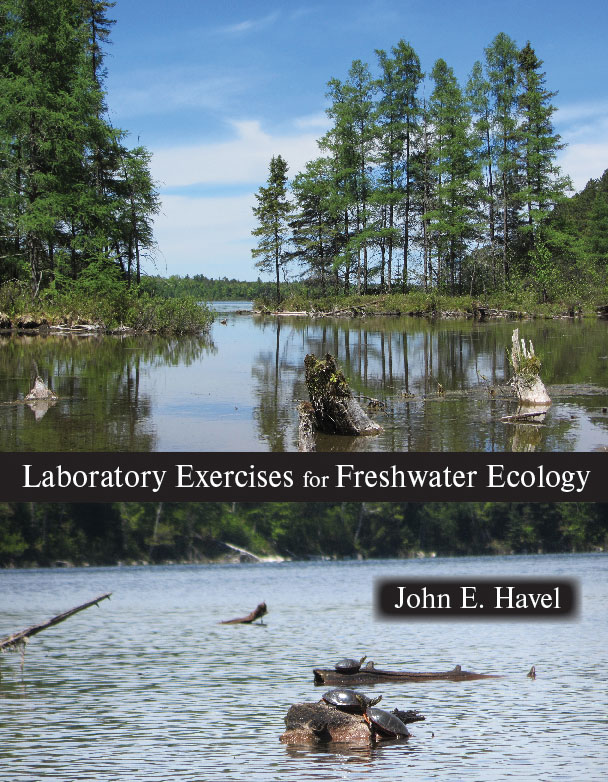“This is an excellent collection of laboratory activities that will complement many upper-level undergraduate and graduate freshwater ecology courses. The detailed instructions and clever demonstrations will be a big help to many instructors.” — David Gillette, University of North Carolina, Asheville
“After evaluating the lab manual, I have decided to use it in my limnology course. The topics are appropriate for an introductory course. Student reading is facilitated by the well-planned format and level of dialogue. Graphics are excellent. I also appreciate the report pages that cover the concepts well and are easy to grade.” — Gary Manfready, Troy State University
“Very useful book. Fairly comprehensive in coverage, complete with materials lists, and accessible to introductory students.” — Craig Williamson, Miami University

179 pages, $52.95 list
1-4786-2679-8
978-1-4786-2679-4
© 2016
spiral
eBook availability
Similar Titles
Laboratory Exercises for Freshwater Ecology
Limnology, stream ecology, and wetland ecology all share an interdisciplinary perspective of inland aquatic habitats. Scientists working in these fields explore the roles of geographic position, physical and chemical properties, and the other biota on the different kinds of plants and animals living in freshwaters. How do these creatures interact with each other and with their physical environment? In what ways have humans impacted aquatic habitats? By what methods do freshwater ecologists study these environments?
With this new laboratory manual, Havel provides a variety of accessible hands-on exercises to illuminate key concepts in freshwater ecology. These exercises include a mixture of field trips, indoor laboratory exercises, and experiments, with some portions involving qualitative observations and others more quantitative. With the help of this manual, students will develop an appreciation for careful techniques used in the laboratory and in the field, as well as an understanding of how to collect accurate field notes, keep a well-organized lab notebook, and write clear scientific reports.
With this new laboratory manual, Havel provides a variety of accessible hands-on exercises to illuminate key concepts in freshwater ecology. These exercises include a mixture of field trips, indoor laboratory exercises, and experiments, with some portions involving qualitative observations and others more quantitative. With the help of this manual, students will develop an appreciation for careful techniques used in the laboratory and in the field, as well as an understanding of how to collect accurate field notes, keep a well-organized lab notebook, and write clear scientific reports.
Reactions
1. Landscapes and Mapping
2. Geomorphology of Streams (Field Trip)
3. Wetland Delineation (Field Trip)
4. Morphometry of Lakes and Reservoirs
5. Hydrology of Streams and Reservoirs
6. Models of Lake Heat and Circulation
7. Stream Characteristics (Field Trip)
8. Vertical Patterns in Lakes and the Use of Sampling Gear (Field Trip)
9. Dissolved Ions and Oxygen
10. Nutrients and Standard Curves
11. Algal Diversity
12. Algal Abundance and Biomass
13. Zooplankton Diversity
14. Zooplankton Enumeration
15. Macroinvertebrate Diversity: Aquatic Insects
16. Macroinvertebrate Diversity: Snails and Bivalves
17. Vertical Migration of Zooplankton (Field Trip)
18. Distribution and Movement of Snails in Streams (Field Trip)
19. Predator Selectivity: Diet Analysis of Stoneflies
20. Predator–Prey Behavior: Crayfish and Snails
21. Leaf Decomposition in Streams: A Field Experiment
22. Bioassays with Ceriodaphnia
23. Bioindicators of Stream Water Quality (Field Trip)
24. Drinking Water Treatment Plant (Guided Tour)
25. Sewage Treatment Plant (Guided Tour)
Lab Notebook and Formal Lab Reports
Appendix A: Key References
Appendix B: Conversion Factors
Appendix C: The Art of Keeping Field Notes
Appendix D: Recipes
2. Geomorphology of Streams (Field Trip)
3. Wetland Delineation (Field Trip)
4. Morphometry of Lakes and Reservoirs
5. Hydrology of Streams and Reservoirs
6. Models of Lake Heat and Circulation
7. Stream Characteristics (Field Trip)
8. Vertical Patterns in Lakes and the Use of Sampling Gear (Field Trip)
9. Dissolved Ions and Oxygen
10. Nutrients and Standard Curves
11. Algal Diversity
12. Algal Abundance and Biomass
13. Zooplankton Diversity
14. Zooplankton Enumeration
15. Macroinvertebrate Diversity: Aquatic Insects
16. Macroinvertebrate Diversity: Snails and Bivalves
17. Vertical Migration of Zooplankton (Field Trip)
18. Distribution and Movement of Snails in Streams (Field Trip)
19. Predator Selectivity: Diet Analysis of Stoneflies
20. Predator–Prey Behavior: Crayfish and Snails
21. Leaf Decomposition in Streams: A Field Experiment
22. Bioassays with Ceriodaphnia
23. Bioindicators of Stream Water Quality (Field Trip)
24. Drinking Water Treatment Plant (Guided Tour)
25. Sewage Treatment Plant (Guided Tour)
Lab Notebook and Formal Lab Reports
Appendix A: Key References
Appendix B: Conversion Factors
Appendix C: The Art of Keeping Field Notes
Appendix D: Recipes